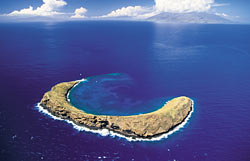The History and Science of Molokini Crater
Archaeology and other studies reveal Molokini Islet's ancient past.
One of Hawaii's best scuba diving and snorkeling sites, Molokini Crater is located about three miles off Maui's southern coast in the Alalakeiki Channel between Maui and the island of Kahoolawe. Graced with clear blue water, the protected reef area at Molokini Islet is abundant with sea life.
Though the crater of Molokini is a very calm place today, the history of this volcanic caldera was one of massive and violent eruptions of lava. According to scientific studies utilizing the technique of potassium-argon dating, the eruptions of Molokini occurred about 230,000 years ago.
The result of Molokini's eruptions is a huge cinder cone that rises above the ocean's surface. The cinder cones is topped by a crater measuring about about 1,800 feet in diameter. The northern rim of the crater is beneath the sea and so the crater is flooded with water.
The ancient Hawaiians caught fish at Molokini, and they caught seabirds for the birds' meat and feathers. The Hawaiians also gathered the eggs of the birds that nested at Molokini.
Today scuba divers at Molokini sometimes come across stone sinkers and other traditional fishing gear that was fashioned by Hawaiians in ancient times. These items along with other evidence has shown that Molokini was an important area for Hawaiians many hundreds of years ago.
During World War II, Molokini was repeatedly bombed by the United States military as the islet was used for target practice. It was said that the shape of the crater resembled a battleship. Other damage to the area occurred in the 1950s when extensive harvesting of the black coral around Molokini occurred.
Unexploded munitions were detonated within the crater in 1975 and again in 1984, destroying large sections of Molokini's coral reef. Molokini's status as a highly protected preserve area now helps in the recovery of the habitat and the various native species living in the land and waters of the islet. These native Hawaiian species include seabirds as well as marine species.
No anchors are allowed (the mooring pins must be used), and no feeding of fish is allowed. Nothing may be removed from Molokini, and the public is not allowed onto the islet itself in order to protect the area.
Researchers are sometimes given permission to walk on the land at Molokini Crater. The tiny islet is federally owned, though it is designated as a state seabird sanctuary.



